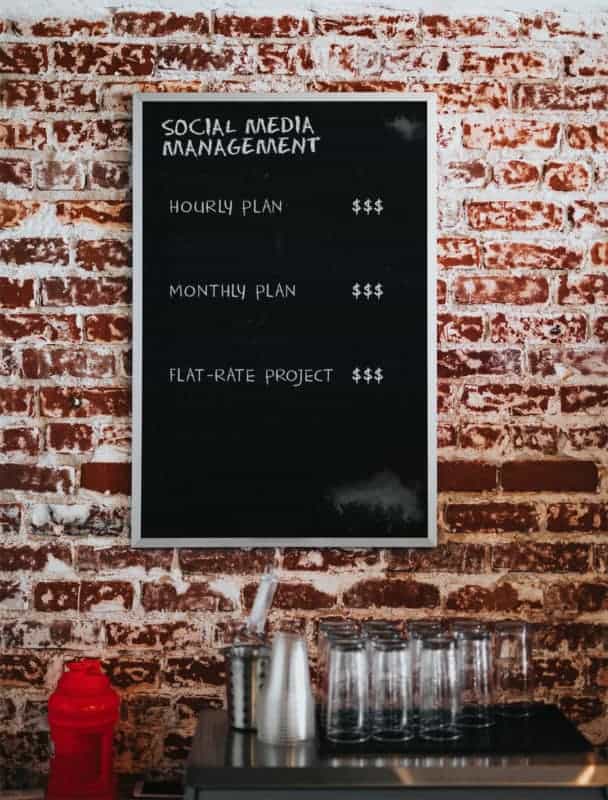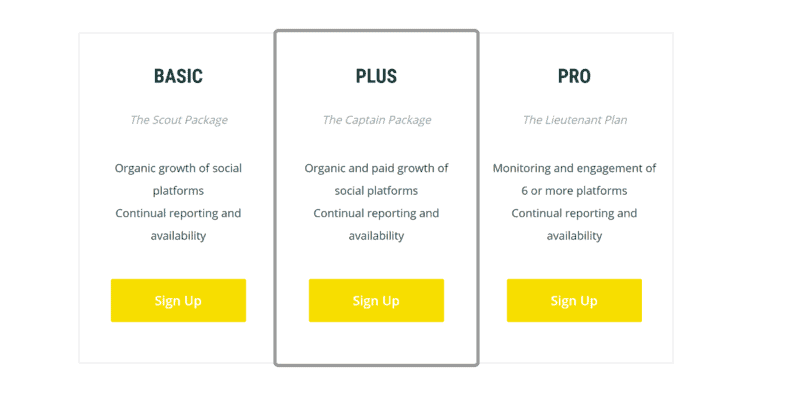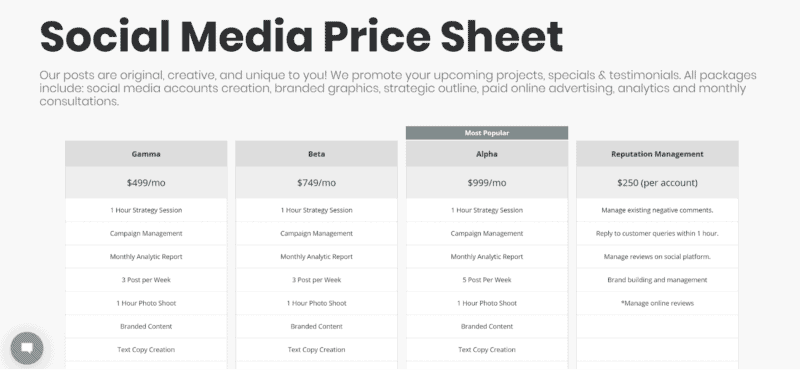Owning your own social media management agency is pretty exciting. You don’t feel like a liar when you use the hashtags #gratitude and #blessed to accompany a picture of your workspace on a Monday morning, because you get to work from anywhere, set your own schedule, and help your clients grow their businesses. But the question remains…how much to charge for your social media management services? Even if you’ve been in business for a couple of years, this question can still haunt you.
Whether you’re just starting out, or trying to figure out how to elevate your current business model (and raise your rates), this post will help you formulate a pricing plan, test it, tweak it, and find the right pricing for your particular business, at this exact point in time. Because obviously, it will change again.
Signs it’s time to change your prices or your pricing model
No matter how long you’ve been in business, these are the warning signs:
- You have an influx of work that you can’t handle
- You can’t keep up with all of your leads
- Everyone who reaches out to you is a “yes” — none of your leads say “no”
- You feel resentful and burnt out
- You can’t hit your financial goals (such as saving a certain percentage for retirement or expenses and investments that will likely help you grow your business)
Any one of these signs might mean you need to raise your prices or change your business model. It might be time to stop charging hourly and start charging a monthly fee for a predetermined service. It might be time to contract work out to others and grow your team, in which case you might need to raise your rates to protect your profit margin.
New to Social Media Management? Read How to Become a Social Media Manager
When you’re just starting out
It’s okay to be a newbie.
If you have no previous work experience in marketing or social media management, it can be tempting to start out on an hourly basis. Many newbie social media managers charge approximately $25 – $35 an hour to start, typically between 10 or 20 hours per month per client. This means that each client is worth $250 – $700 per month.
However, it’s very hard to earn a reasonable living charging that amount when you’re self-employed. Creating pricing packages and retainers (which allow you to earn more) requires confidence and experience to do them right. So for the first 3 – 6 months of your business, go ahead and charge hourly if you feel more comfortable doing so. But then once you have experience and can create case studies for your work, it’s time to move towards packages.
Let’s explore why that is.
Should you use social media management pricing packages?
There are different ways to charge for social media management:
- Hourly
- Monthly rate
- Flat project rate
An example of a flat project rate could be to help a business set up their social media accounts or for a new product launch. The easiest way to do that would be to determine what you want to make hourly, estimate the project, and then provide a flat quote.
However, this type of work isn’t very common within social media management.
Most businesses are looking for someone to help them grow and maintain their social media following over time. They don’t want a one-off project.
Because social media management is ongoing, it represents recurring income for you as a business owner. Recurring revenue allows you to focus on serving your clients without having to always bring new clients in the door every month.
While some inexperienced social media managers may choose to charge hourly, this quickly becomes a problem. It’s hard to scale, hard to outsource if you decide to grow your business, and it’s hard to raise your rates because business owners get nervous about paying higher amounts. While it is absolutely possible to charge $100+/hr, it isn’t necessarily easy.
Pricing packages solve all of these problems. Here are the benefits of creating monthly packages for your work:
- Regular, recurring income from clients
- Clients know what to expect to pay every month
- Showcase your expertise by creating packages that meet their needs
- Make it easy for clients to choose which package fits them—too many options can kill sales
- Scale your business more easily if you decide to
There also are downsides to monthly package-based pricing:
- Clients might push the boundaries of what’s included
- It’s hard to come up with packages that reflect reality (especially if you’re inexperienced)
- Some clients won’t fit into your preset boxes
Even still, these negatives don’t outweigh the positives. For social media management services, monthly packages are the most desirable way to charge. And there are workarounds for the clients who need a custom package.
For agencies working with medium or large enterprises, preset packages may be impossible. Packages are a great fit for agencies working with small to medium-sized businesses, but with complex organizations with dozens of social media accounts potentially across different brand lines, regions, and even languages…you’ll need to master custom pricing, which I discuss in detail below.
What to do when prospective clients don’t fit into your packages
Package-based pricing is very trendy right now. It’s not only trendy with social media management. It’s trendy with graphic designers, copywriters, other types of consultants, business coaches…pretty much everybody.
But package-based pricing can cause a lot of anxiety. What do you do if the client doesn’t fit into one of your packages? Do you let them go? Absolutely not! Provided they would make a great client, you should create a custom package.
Here’s an example of what this might look like in your business.
-
- The Sparkle Package: Manage 2 accounts including content creation and engagement
- The Firework Package: Manage 4 – 5 accounts including content creation and engagement
- The Lightning Package: Manage 5 – 6 accounts including content creation, engagement, influencer marketing management and user-generated content management
- Custom package: Internally, create a flat rate price sheet with a monthly price on everything you do, from the copywriting work to the design work to scheduling to engagement. And also special services like influencer marketing management and user-generated content management. Then on a sales call, when a lead doesn’t fit into your small, medium or large package, simply add up what services they need to provide them with an accurate quote. You can give the quote over the phone, or follow up via email after your call.
The 5-step process to determine how much to charge for social media management
There’s no one-size-fits-all answer. Some social media agencies are husband-wife teams who work with small, local businesses. Other agencies have 20+ employees and 100+ clients around the world.
It would be absurd to give you a number and send you on your merry way.
But ranges are silly too. Knowing that most social media management freelancers charge $200 – $1,000 per month and that most social media management agencies charge $500 – $10,000 per month doesn’t help you.
What you need is a process of finding the number that is right for you, your business, and your clients.
Step 1: Research what your direct competitors are charging
Not every competitor is a direct competitor. Don’t waste your time looking at what freelancers are doing if you’re a full-service agency. Your competitors are only your competitors if these factors are similar:
- Number of employees
- Client industry
- Client company size (again, # of employees is a good determining factor)
- Services
Some agencies offer influencer marketing and even paid advertising management. Others only offer organic posting, follower growth and engagement.
If you provide more of a boutique, customized service, then a company like WebFX is not a direct competitor to you. This company is built for scale and doesn’t have a specific niche.
Build up a list of 3 – 8 direct competitors and see if you can find out what they charge. They may not list pricing on their website. If they don’t, and it’s a small business, you might be able to make friends slowly over time and then work together on establishing similar pricing. Does that idea surprise you? The world is a big place and there’s enough work to go around. Getting to know your direct competitors on a personal level and becoming friendly is increasingly common in the digital work world. Try it out!
Step 2: Take stock of feedback to your existing pricing
Now it’s time to stop looking at what your competitors are doing and start looking at what you’re doing.
- For your last 10 sales calls, how many price objections did you get?
- For your last 10 sales calls, did anyone hint that you were far cheaper than other alternatives?
- When you discuss pricing with prospects over email, what reactions do you get?
- If you have your prices listed on your website, have you noticed an increase or a decrease in inbound leads lately?
Take a good hard look at the amounts you’re quoting people. A good rule of thumb is to have 50% of leads think you’re expensive, and 50% of leads think you’re a steal. If everyone thinks you’re too expensive, then you haven’t done a good job showcasing the results of your work (with case studies) and your rates might be higher than warranted. If everyone thinks you’re a steal, you’re most certainly undercharging for the value you provide and stunting your own business growth.
Step 3: Consider the needs of your best-fit clients
After you’ve looked at what your competitors charge and taken an objective view of what you’re charging, the next step is to brainstorm what your best-fit clients need.
- Who are your favorite clients to work with?
- Which clients have you gotten the best results for in terms of impressions, account growth, sales, and leads?
- What have you done in order to produce those results?
- Can you duplicate that into a monthly package for other clients?
Step 4: Create your preset packages and custom package pricing
Your discovery from Step 3 will make the perfect middle-tier package. Think of this as the package you hope new clients will choose, simply because it was designed for your best-fit clients. Then you’ll want to create a package that is smaller than this, and also larger.
See this example from Yellow Hyena:
Note that there is no pricing associated with these social media management packages. Just because you have packages, doesn’t mean you need to share your pricing. In fact, you can even customize your pricing within your packages for your clients if needed.
Here’s an example of a social media management agency’s pricing page that does include the price amount.
It’s important to create your prices and your packages whether you put them on your website or not. This way, you can provide quick and accurate quotes to your prospects. Later, you can test putting them on your site—or not.
Step 5: Test your new pricing with prospects and current clients
Lastly, it’s time to implement your new pricing. With new prospects, quote them your new rates. Tell them about your three packages and help them decide which is the right one for them, or if they have unique needs, customize a package based on your building blocks of flat rates. Similar to Step 2, you need to pay attention to the feedback you’re getting. You want to hit the sweet spot, where a few people still think you’re too pricey (this should always happen), but half or more of your prospects are a certain “yes.”
When you feel good about your new pricing, roll it out to existing clients and give them a one or two-month heads up. Their response, meaning how many stick around, will also put your new pricing to the test. So make sure you feel good and ready before you implement.
To sum up, there is no one-size-fits-all answer. Use these 5 steps to determine what you should charge for social media management. When you experience growing pains in a year or so, start the 5-step process all over again.
Did you know? MavSocial has a plan designed specifically for agencies. Our platform helps you manage multiple clients, send stunning reports and even get approval for posts before they go live. Learn more.








